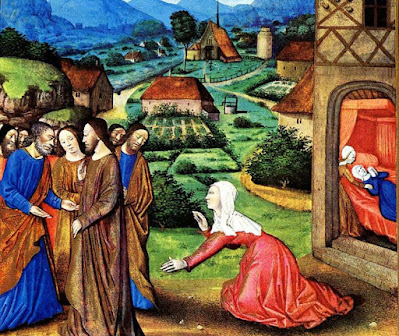This Gospel account describes it for us:
John the Baptist was the last of the Old Testament prophets, and he was the first New Testament prophet. Of course, he was treated like most of the prophets were – he was hated for speaking the truth. Sent by God to prepare the people for the Messiah, his vocation was one of selfless giving. The only power he claimed was the Spirit of God. “I am baptizing you with water, for repentance, but the one who is coming after me is mightier than I. I am not worthy to carry his sandals. He will baptize you with the Holy Spirit and fire” (Matthew 3:11).
Scripture tells us that many people followed John looking to him for hope, perhaps in anticipation of some great messianic power. John never allowed himself the false honour of receiving these people for his own glory. He knew his calling was one of preparation. When the time came, he led his disciples to Jesus: “The next day John was there again with two of his disciples, and as he watched Jesus walk by, he said, ‘Behold, the Lamb of God.’ The two disciples heard what he said and followed Jesus” (John 1:35-37), and so the life and death of St. John the Baptist had the great purpose of pointing the way to Christ.
Herod had sent and seized John, and bound him in prison for the sake of Herodias, his brother Philip's wife; because he had married her. For John said to Herod, "It is not lawful for you to have your brother's wife." And Herodias had a grudge against him, and wanted to kill him. But she could not, for Herod feared John, knowing that he was a righteous and holy man, and kept him safe. When he heard him, he was much perplexed; and yet he heard him gladly. But an opportunity came when Herod on his birthday gave a banquet for his courtiers and officers and the leading men of Galilee. For when Herodias' daughter came in and danced, she pleased Herod and his guests; and the king said to the girl, "Ask me for whatever you wish, and I will grant it." And he vowed to her, "Whatever you ask me, I will give you, even half of my kingdom." And she went out, and said to her mother, "What shall I ask?" And she said, "The head of John the baptizer." And she came in immediately with haste to the king, and asked, saying, "I want you to give me at once the head of John the Baptist on a platter." And the king was exceedingly sorry; but because of his oaths and his guests he did not want to break his word to her. And immediately the king sent a soldier of the guard and gave orders to bring his head. He went and beheaded him in the prison, and brought his head on a platter, and gave it to the girl; and the girl gave it to her mother. When his disciples heard of it, they came and took his body, and laid it in a tomb.
- St. Mark 6:17-29
John the Baptist was the last of the Old Testament prophets, and he was the first New Testament prophet. Of course, he was treated like most of the prophets were – he was hated for speaking the truth. Sent by God to prepare the people for the Messiah, his vocation was one of selfless giving. The only power he claimed was the Spirit of God. “I am baptizing you with water, for repentance, but the one who is coming after me is mightier than I. I am not worthy to carry his sandals. He will baptize you with the Holy Spirit and fire” (Matthew 3:11).
Scripture tells us that many people followed John looking to him for hope, perhaps in anticipation of some great messianic power. John never allowed himself the false honour of receiving these people for his own glory. He knew his calling was one of preparation. When the time came, he led his disciples to Jesus: “The next day John was there again with two of his disciples, and as he watched Jesus walk by, he said, ‘Behold, the Lamb of God.’ The two disciples heard what he said and followed Jesus” (John 1:35-37), and so the life and death of St. John the Baptist had the great purpose of pointing the way to Christ.
Almighty God, by whose grace and power thy servant St. John the Baptist triumphed over suffering and despised death: Grant, we beseech thee, that we, enduring hardness and waxing valiant in fight, may with the noble army of martyrs receive the crown of everlasting life; through Jesus Christ our Lord, who liveth and reigneth with thee and the Holy Spirit, one God, for ever and ever. Amen.
_____________________________________
"The Beheading of St. John the Baptist" ca. 1869
by Pierre Puvis de Chavannes





,_Saint_Bartholomew,_ca._1497.jpg)












